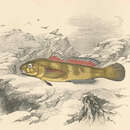Diagnostic Description
provided by Fishbase
Neck naked. No black spots in the front end of each dorsal fin (Ref. 35388).
- Recorder
- Arlene G. Sampang-Reyes
Life Cycle
provided by Fishbase
Oviparous (Ref. 205). Male guards the eggs deposited by the female under rocks or inside empty bivalve shells until they hatch (Ref. 45332). Larvae remain near the substrate until they assume the cryptobenthic behavior of the adults (Ref. 45332). Are repeat spawners (Ref. 4696).
Migration
provided by Fishbase
Amphidromous. Refers to fishes that regularly migrate between freshwater and the sea (in both directions), but not for the purpose of breeding, as in anadromous and catadromous species. Sub-division of diadromous. Migrations should be cyclical and predictable and cover more than 100 km.Characteristic elements in amphidromy are: reproduction in fresh water, passage to sea by newly hatched larvae, a period of feeding and growing at sea usually a few months long, return to fresh water of well-grown juveniles, a further period of feeding and growing in fresh water, followed by reproduction there (Ref. 82692).
Trophic Strategy
provided by Fishbase
Common inshore and intertidal species, under stones and in pools on sheltered rocky shores with much weed cover (Ref. 122774). Also found on seagrass beds (Ref. 122775).
Biology
provided by Fishbase
Predominantly marine, but may enter freshwater. Adults occur inshore in intertidal waters, under stones and in pools on sheltered rocky shores with much weed cover. Macrobenthos feeder on hard substrates (Ref. 92840), they feed on crustaceans (larger amphipods, isopods, small crabs) and polychaetes; juveniles eat harpacticoid copepods, amphipods, polychaetes and mites (Ref. 4696). Oviparous (Ref. 205). Fusiform shaped eggs are found in patches of several thousand on undersurface of stones, shells, polychaete tubes or Ciona mantles (Ref. 4696).
Importance
provided by Fishbase
fisheries: minor commercial; aquarium: public aquariums; price category: very high; price reliability: very questionable: based on ex-vessel price for species in this family

